HIV-1C env and gag Variation in the Cerebrospinal Fluid and Plasma of Patients with HIV-Associated Cryptococcal Meningitis in Botswana
Abstract
:1. Introduction
2. Materials and Methods
2.1. Study Population
2.2. Ethical Consideration
2.3. HIV-1 RNA Quantification and Extraction
2.4. HIV-1 DNA Amplification and Sequencing
2.5. Phylogenetic Analyses
2.6. Prediction of Co-Receptor Usage
2.7. Identification of N-Linked Glycosylation Sites
2.8. Identification of HIV-1 gag Associated Mutations
2.9. Statistical Analysis
3. Results
3.1. Patient Characteristics
3.2. Phylogenetic Analysis
3.3. HIV-1 Co-Receptor Usage in CSF and Plasma
3.4. PNGSs in HIV-1 V2, V3 and V4 Loop Derived from CSF and Plasma Samples
3.5. Mutations in the V3 Loop Region of HIV-1 gp120 in CSF and Plasma
3.6. HIV-1 gag-Associated Mutations in CSF and Plasma
4. Discussion
5. Conclusions
Supplementary Materials
Author Contributions
Funding
Acknowledgments
Conflicts of Interest
References
- Sturdevant, C.B.; Joseph, S.B.; Schnell, G.; Price, R.W.; Swanstrom, R.; Spudich, S. Compartmentalized replication of R5 T cell-tropic HIV-1 in the central nervous system early in the course of infection. PLoS Pathog. 2015, 11, e1004720. [Google Scholar] [CrossRef] [Green Version]
- Schnell, G.; Price, R.W.; Swanstrom, R.; Spudich, S. Compartmentalization and Clonal Amplification of HIV-1 Variants in the Cerebrospinal Fluid during Primary Infection. J. Virol. 2010, 84, 2395. [Google Scholar] [CrossRef] [Green Version]
- Nickle, D.C.; Jensen, M.A.; Shriner, D.; Brodie, S.J.; Frenkel, L.M.; Mittler, J.E.; Mullins, J.I. Evolutionary indicators of human immunodeficiency virus type 1 reservoirs and compartments. J. Virol. 2003, 77, 5540–5546. [Google Scholar] [CrossRef] [Green Version]
- Oliveira, M.F.; Chaillon, A.; Nakazawa, M.; Vargas, M.; Letendre, S.L.; Strain, M.C.; Ellis, R.J.; Morris, S.; Little, S.J.; Smith, D.M.; et al. Early Antiretroviral Therapy Is Associated with Lower HIV DNA Molecular Diversity and Lower Inflammation in Cerebrospinal Fluid but Does Not Prevent the Establishment of Compartmentalized HIV DNA Populations. PLoS Pathog. 2017, 13, e1006112. [Google Scholar] [CrossRef]
- Hellmuth, J.; Valcour, V.; Spudich, S. CNS reservoirs for HIV: Implications for eradication. J. Virus Erad. 2015, 1, 67–71. [Google Scholar] [CrossRef]
- Seipone, I.D.; Singh, R.; Patel, V.B.; Singh, A.; Gordon, M.L.; Muema, D.M.; Dheda, K.; Ndung’u, T. Tuberculous meningitis is associated with higher cerebrospinal HIV-1 viral loads compared to other HIV-1-associated meningitides. PLoS ONE 2018, 13, e0192060. [Google Scholar] [CrossRef] [Green Version]
- Cecchini, D.M.; Cañizal, A.M.; Rojas, H.; Arechavala, A.; Negroni, R.; Bouzas, M.B.; Benetucci, J.A. Variables that influence HIV-1 cerebrospinal fluid viral load in cryptococcal meningitis: A linear regression analysis. J. Int. AIDS Soc. 2009, 12, 33. [Google Scholar] [CrossRef] [Green Version]
- Chang, C.C.; Kangethe, R.; Omarjee, S.; Hiramen, K.; Gosnell, B.; Sojane, K.; Moosa, M.-Y.S.; Lewin, S.R.; French, M.A.; Ndung’u, T. Relationship of Human Immunodeficiency Virus Viral Load in Cerebrospinal Fluid and Plasma in Patients Co-infected With Cryptococcal Meningitis. Open Forum Infect. Dis. 2017, 4, ofx032. [Google Scholar] [CrossRef] [Green Version]
- Sojane, K.; Kangethe, R.T.; Chang, C.C.; Moosa, M.-Y.S.; Lewin, S.R.; French, M.A.; Ndung’u, T. Individuals with HIV-1 Subtype C Infection and Cryptococcal Meningitis Exhibit Viral Genetic Intermixing of HIV-1 Between Plasma and Cerebrospinal Fluid and a High Prevalence of CXCR4-Using Variants. AIDS Res. Hum. Retrovir. 2018, 34, 607–620. [Google Scholar] [CrossRef]
- Parisi, S.G.; Andreoni, C.; Sarmati, L.; Boldrin, C.; Buonomini, A.R.; Andreis, S.; Scaggiante, R.; Cruciani, M.; Bosco, O.; Manfrin, V.; et al. HIV coreceptor tropism in paired plasma, peripheral blood mononuclear cell, and cerebrospinal fluid isolates from antiretroviral-naïve subjects. J. Clin. Microbiol. 2011, 49, 1441–1445. [Google Scholar] [CrossRef] [Green Version]
- Sattentau, Q.J.; Moore, J.P. Conformational changes induced in the human immunodeficiency virus envelope glycoprotein by soluble CD4 binding. J. Exp. Med. 1991, 174, 407–415. [Google Scholar] [CrossRef] [PubMed]
- Berson, J.F.; Long, D.; Doranz, B.J.; Rucker, J.; Jirik, F.R.; Doms, R.W. A seven-transmembrane domain receptor involved in fusion and entry of T-cell-tropic human immunodeficiency virus type 1 strains. J. Virol. 1996, 70, 6288–6295. [Google Scholar] [CrossRef] [Green Version]
- Pessôa, R.; Sabino, E.C.; Sanabani, S.S. Frequency of coreceptor tropism in PBMC samples from HIV-1 recently infected blood donors by massively parallel sequencing: The REDS II study. Virol. J. 2015, 12, 74. [Google Scholar] [CrossRef] [Green Version]
- Esbjörnsson, J.; Månsson, F.; Martínez-Arias, W.; Vincic, E.; Biague, A.J.; da Silva, Z.J.; Fenyö, E.M.; Norrgren, H.; Medstrand, P. Frequent CXCR4 tropism of HIV-1 subtype A and CRF02_AG during late-stage disease--indication of an evolving epidemic in West Africa. Retrovirology 2010, 7, 23. [Google Scholar] [CrossRef] [Green Version]
- Schnell, G.; Joseph, S.; Spudich, S.; Price, R.W.; Swanstrom, R. HIV-1 Replication in the Central Nervous System Occurs in Two Distinct Cell Types. PLoS Pathog. 2011, 7, e1002286. [Google Scholar] [CrossRef] [Green Version]
- Cilliers, T.; Nhlapo, J.; Coetzer, M.; Orlovic, D.; Ketas, T.; Olson, W.C.; Moore, J.P.; Trkola, A.; Morris, L. The CCR5 and CXCR4 coreceptors are both used by human immunodeficiency virus type 1 primary isolates from subtype C. J. Virol. 2003, 77, 4449–4456. [Google Scholar] [CrossRef] [Green Version]
- Tremblay, C.; Hardy, I.; Lalonde, R.; Trottier, B.; Tsarevsky, I.; Vézina, L.-P.; Roger, M.; Wainberg, M.; Baril, J.-G. HIV-1 tropism testing and clinical management of CCR5 antagonists: Quebec review and recommendations. Can. J. Infect. Dis. Med. Microbiol. 2013, 24, 202–208. [Google Scholar] [CrossRef] [Green Version]
- Doores, K.J. The HIV glycan shield as a target for broadly neutralizing antibodies. FEBS J. 2015, 282, 4679–4691. [Google Scholar] [CrossRef] [Green Version]
- Ho, Y.S.; Abecasis, A.B.; Theys, K.; Deforche, K.; Dwyer, D.E.; Charleston, M.; Vandamme, A.M.; Saksena, N.K. HIV-1 gp120 N-linked glycosylation differs between plasma and leukocyte compartments. Virol. J. 2008, 5, 14. [Google Scholar] [CrossRef] [Green Version]
- Gianella, S.; Pond, S.L.K.; Oliveira, M.F.; Scheffler, K.; Strain, M.C.; De la Torre, A.; Letendre, S.; Smith, D.M.; Ellis, R.J. Compartmentalized HIV rebound in the central nervous system after interruption of antiretroviral therapy. Virus Evol. 2016, 2, vew020. [Google Scholar] [CrossRef] [PubMed] [Green Version]
- Borderia, A.V.; Codoner, F.M.; Sanjuan, R. Selection promotes organ compartmentalization in HIV-1: Evidence from gag and pol genes. Evolution 2007, 61, 272–279. [Google Scholar] [CrossRef]
- Queen, S.E.; Mears, B.M.; Kelly, K.M.; Dorsey, J.L.; Liao, Z.; Dinoso, J.B.; Gama, L.; Adams, R.J.; Zink, M.C.; Clements, J.E.; et al. Replication-competent simian immunodeficiency virus (SIV) Gag escape mutations archived in latent reservoirs during antiretroviral treatment of SIV-infected macaques. J. Virol. 2011, 85, 9167–9175. [Google Scholar] [CrossRef] [Green Version]
- Jarvis, J.N.; Leeme, T.B.; Molefi, M.; Chofle, A.A.; Bidwell, G.; Tsholo, K.; Tlhako, N.; Mawoko, N.; Patel, R.K.K.; Tenforde, M.W.; et al. Short-course High-dose Liposomal Amphotericin B for Human Immunodeficiency Virus–associated Cryptococcal Meningitis: A Phase 2 Randomized Controlled Trial. Clin. Infect. Dis. 2018, 68, 393–401. [Google Scholar] [CrossRef]
- Guindon, S.; Dufayard, J.-F.; Lefort, V.; Anisimova, M.; Hordijk, W.; Gascuel, O. New Algorithms and Methods to Estimate Maximum-Likelihood Phylogenies: Assessing the Performance of PhyML 3.0. Syst. Biol. 2010, 59, 307–321. [Google Scholar] [CrossRef] [Green Version]
- Pineda-Peña, A.-C.; Faria, N.R.; Imbrechts, S.; Libin, P.; Abecasis, A.B.; Deforche, K.; Gómez-López, A.; Camacho, R.J.; de Oliveira, T.; Vandamme, A.-M. Automated subtyping of HIV-1 genetic sequences for clinical and surveillance purposes: Performance evaluation of the new REGA version 3 and seven other tools. Infect. Genet. Evol. 2013, 19, 337–348. [Google Scholar] [CrossRef] [Green Version]
- Struck, D.; Lawyer, G.; Ternes, A.-M.; Schmit, J.-C.; Bercoff, D.P. COMET: Adaptive context-based modeling for ultrafast HIV-1 subtype identification. Nucleic Acids Res. 2014, 42, e144. [Google Scholar] [CrossRef]
- Raymond, S.; Delobel, P.; Mavigner, M.; Ferradini, L.; Cazabat, M.; Souyris, C.; Sandres-Sauné, K.; Pasquier, C.; Marchou, B.; Massip, P.; et al. Prediction of HIV Type 1 Subtype C Tropism by Genotypic Algorithms Built From Subtype B Viruses. JAIDS J. Acquir. Immune Defic. Syndr. 2010, 53, 167–175. [Google Scholar] [CrossRef]
- Novitsky, V.; Flores-Villanueva, P.O.; Chigwedere, P.; Gaolekwe, S.; Bussman, H.; Sebetso, G.; Marlink, R.; Yunis, E.J.; Essex, M. Identification of most frequent HLA class I antigen specificities in Botswana: Relevance for HIV vaccine design. Hum. Immunol. 2001, 62, 146–156. [Google Scholar] [CrossRef]
- RStudio Team. RStudio: Integrated Development Environment for R; 1.2.1335; RStudio, Inc.: Boston, MA, USA, 2018. [Google Scholar]
- Westby, M.; Smith-Burchnell, C.; Mori, J.; Lewis, M.; Mosley, M.; Stockdale, M.; Dorr, P.; Ciaramella, G.; Perros, M. Reduced maximal inhibition in phenotypic susceptibility assays indicates that viral strains resistant to the CCR5 antagonist maraviroc utilize inhibitor-bound receptor for entry. J. Virol. 2007, 81, 2359–2371. [Google Scholar] [CrossRef] [Green Version]
- Joseph, S.B.; Kincer, L.P.; Bowman, N.M.; Evans, C.; Vinikoor, M.J.; Lippincott, C.K.; Gisslén, M.; Spudich, S.; Menezes, P.; Robertson, K.; et al. Human Immunodeficiency Virus Type 1 RNA Detected in the Central Nervous System (CNS) After Years of Suppressive Antiretroviral Therapy Can Originate from a Replicating CNS Reservoir or Clonally Expanded Cells. Clin. Infect. Dis. 2019, 69, 1345–1352. [Google Scholar] [CrossRef]
- Mukerji, S.S.; Misra, V.; Lorenz, D.; Cervantes-Arslanian, A.M.; Lyons, J.; Chalkias, S.; Wurcel, A.; Burke, D.; Venna, N.; Morgello, S.; et al. Temporal Patterns and Drug Resistance in CSF Viral Escape Among ART-Experienced HIV-1 Infected Adults. JAIDS J. Acquir. Immune Defic. Syndr. (1999) 2017, 75, 246–255. [Google Scholar] [CrossRef]
- Moreno-Gamez, S.; Hill, A.L.; Rosenbloom, D.I.S.; Petrov, D.A.; Nowak, M.A.; Pennings, P.S. Imperfect drug penetration leads to spatial monotherapy and rapid evolution of multidrug resistance. Proc. Natl. Acad. Sci. USA 2015, 112, E2874. [Google Scholar] [CrossRef] [Green Version]
- Patel, A.K.; Patel, K.K.; Gohel, S.; Kumar, A.; Letendre, S. Incidence of symptomatic CSF viral escape in HIV infected patients receiving atazanavir/ritonavir (ATV/r)-containing ART: A tertiary care cohort in western India. J. Neurovirol. 2018, 24, 498–505. [Google Scholar] [CrossRef]
- Lin, N.; Smeaton, L.; Giguel, F.; Novitsky, V.; Moyo, S.; Mitchell, R.; Makhema, J.; Essex, M.; Lockman, S.; Kuritzkes, D. Prevalence and Clinical Associations of CXCR4-Using HIV-1 Among Treatment-Naive Subtype C-Infected Women in Botswana. JAIDS J. Acquir. Immune Defic. Syndr. (1999) 2011, 57, 46–50. [Google Scholar] [CrossRef] [Green Version]
- Karlsson, U.; Antonsson, L.; Repits, J.; Medstrand, P.; Owman, C.; Kidd-Ljunggren, K.; Hagberg, L.; Svennerholm, B.; Jansson, M.; Gisslén, M.; et al. Mode of coreceptor use by R5 HIV type 1 correlates with disease stage: A study of paired plasma and cerebrospinal fluid isolates. AIDS Res. Hum. Retrovir. 2009, 25, 1297–1305. [Google Scholar] [CrossRef] [Green Version]
- Soulié, C.; Tubiana, R.; Simon, A.; Lambert-Niclot, S.; Malet, I.; Canestri, A.; Brunet, C.; Murphy, R.; Katlama, C.; Calvez, V.; et al. Presence of HIV-1 R5 viruses in cerebrospinal fluid even in patients harboring R5X4/X4 viruses in plasma. JAIDS J. Acquir. Immune Defic. Syndr. 2009, 51, 60–64. [Google Scholar] [CrossRef]
- Vázquez-Santiago, F.; García, Y.; Rivera-Román, I.; Noel, R.J., Jr.; Wojna, V.; Meléndez, L.M.; Rivera-Amill, V. Longitudinal Analysis of Cerebrospinal Fluid and Plasma HIV-1 Envelope Sequences Isolated From a Single Donor with HIV Asymptomatic Neurocognitive Impairment. J. Virol. Antivir. Res. 2015, 4. [Google Scholar] [CrossRef]
- Pillai, S.K.; Pond, S.L.K.; Liu, Y.; Good, B.M.; Strain, M.C.; Ellis, R.J.; Letendre, S.; Smith, D.M.; Günthard, H.F.; Grant, I.; et al. Genetic attributes of cerebrospinal fluid-derived HIV-1 env. Brain 2006, 129, 1872–1883. [Google Scholar] [CrossRef]
- Dunfee, R.L.; Thomas, E.R.; Wang, J.; Kunstman, K.; Wolinsky, S.M.; Gabuzda, D. Loss of the N-linked glycosylation site at position 386 in the HIV envelope V4 region enhances macrophage tropism and is associated with dementia. Virology 2007, 367, 222–234. [Google Scholar] [CrossRef] [Green Version]
- Zhang, M.; Gaschen, B.; Blay, W.; Foley, B.; Haigwood, N.; Kuiken, C.; Korber, B. Tracking global patterns of N-linked glycosylation site variation in highly variable viral glycoproteins: HIV, SIV, and HCV envelopes and influenza hemagglutinin. Glycobiology 2004, 14, 1229–1246. [Google Scholar] [CrossRef] [Green Version]
- Travers, S.A. Conservation, Compensation, and Evolution of N-Linked Glycans in the HIV-1 Group M Subtypes and Circulating Recombinant Forms. ISRN AIDS 2012, 2012, 823605. [Google Scholar] [CrossRef] [Green Version]
- Agwu, A.L.; Yao, T.-J.; Eshleman, S.H.; Patel, K.; Huang, W.; Burchett, S.K.; Siberry, G.K.; Van Dyke, R.B.; Pediatric, H.C.S. Phenotypic Coreceptor Tropism in Perinatally HIV-infected Youth Failing Antiretroviral Therapy. Pediatr. Infect. Dis. J. 2016, 35, 777–781. [Google Scholar] [CrossRef] [PubMed] [Green Version]
- Moyo, T.; Ferreira, R.-C.; Davids, R.; Sonday, Z.; Moore, P.L.; Travers, S.A.; Wood, N.T.; Dorfman, J.R. Chinks in the armor of the HIV-1 Envelope glycan shield: Implications for immune escape from anti-glycan broadly neutralizing antibodies. Virology 2017, 501, 12–24. [Google Scholar] [CrossRef] [PubMed]
- Doores, K.J.; Burton, D.R. Variable Loop Glycan Dependency of the Broad and Potent HIV-1-Neutralizing Antibodies PG9 and PG16. J. Virol. 2010, 84, 10510. [Google Scholar] [CrossRef] [PubMed] [Green Version]
- Walter, B.L.; Armitage, A.E.; Graham, S.C.; de Oliveira, T.; Skinhøj, P.; Jones, E.Y.; Stuart, D.I.; McMichael, A.J.; Chesebro, B.; Iversen, A.K. Functional characteristics of HIV-1 subtype C compatible with increased heterosexual transmissibility. AIDS (London, England) 2009, 23, 1047–1057. [Google Scholar] [CrossRef] [PubMed] [Green Version]
- Araújo, L.A.L.; Junqueira, D.M.; de Medeiros, R.M.; Matte, M.C.C.; Almeida, S.E.d.M. Naturally occurring resistance mutations to HIV-1 entry inhibitors in subtypes B, C, and CRF31_BC. J. Clin. Virol. 2012, 54, 6–10. [Google Scholar] [CrossRef]
- Gonzalez, S.; Tully, D.C.; Gondwe, C.; Wood, C. Low-abundance resistant mutations in HIV-1 subtype C antiretroviral therapy-naive individuals as revealed by pyrosequencing. Curr. HIV Res. 2013, 11, 43–49. [Google Scholar]
- Cardoso, C.A.A.; Pinto, J.A.; Candiani, T.M.S.; Carvalho, I.R.d.; Linhares, R.M.; Goulart, E.M.A. The impact of highly active antiretroviral therapy on the survival of vertically HIV-infected children and adolescents in Belo Horizonte, Brazil. Mem. Inst. Oswaldo Cruz 2012, 107, 532–538. [Google Scholar] [CrossRef] [Green Version]
- Leslie, A.J.; Pfafferott, K.J.; Chetty, P.; Draenert, R.; Addo, M.M.; Feeney, M.; Tang, Y.; Holmes, E.C.; Allen, T.; Prado, J.G.; et al. HIV evolution: CTL escape mutation and reversion after transmission. Nat. Med. 2004, 10, 282–289. [Google Scholar] [CrossRef]
- Brockman, M.A.; Schneidewind, A.; Lahaie, M.; Schmidt, A.; Miura, T.; Desouza, I.; Ryvkin, F.; Derdeyn, C.A.; Allen, S.; Hunter, E.; et al. Escape and compensation from early HLA-B57-mediated cytotoxic T-lymphocyte pressure on human immunodeficiency virus type 1 Gag alter capsid interactions with cyclophilin A. J. Virol. 2007, 81, 12608–12618. [Google Scholar] [CrossRef] [Green Version]
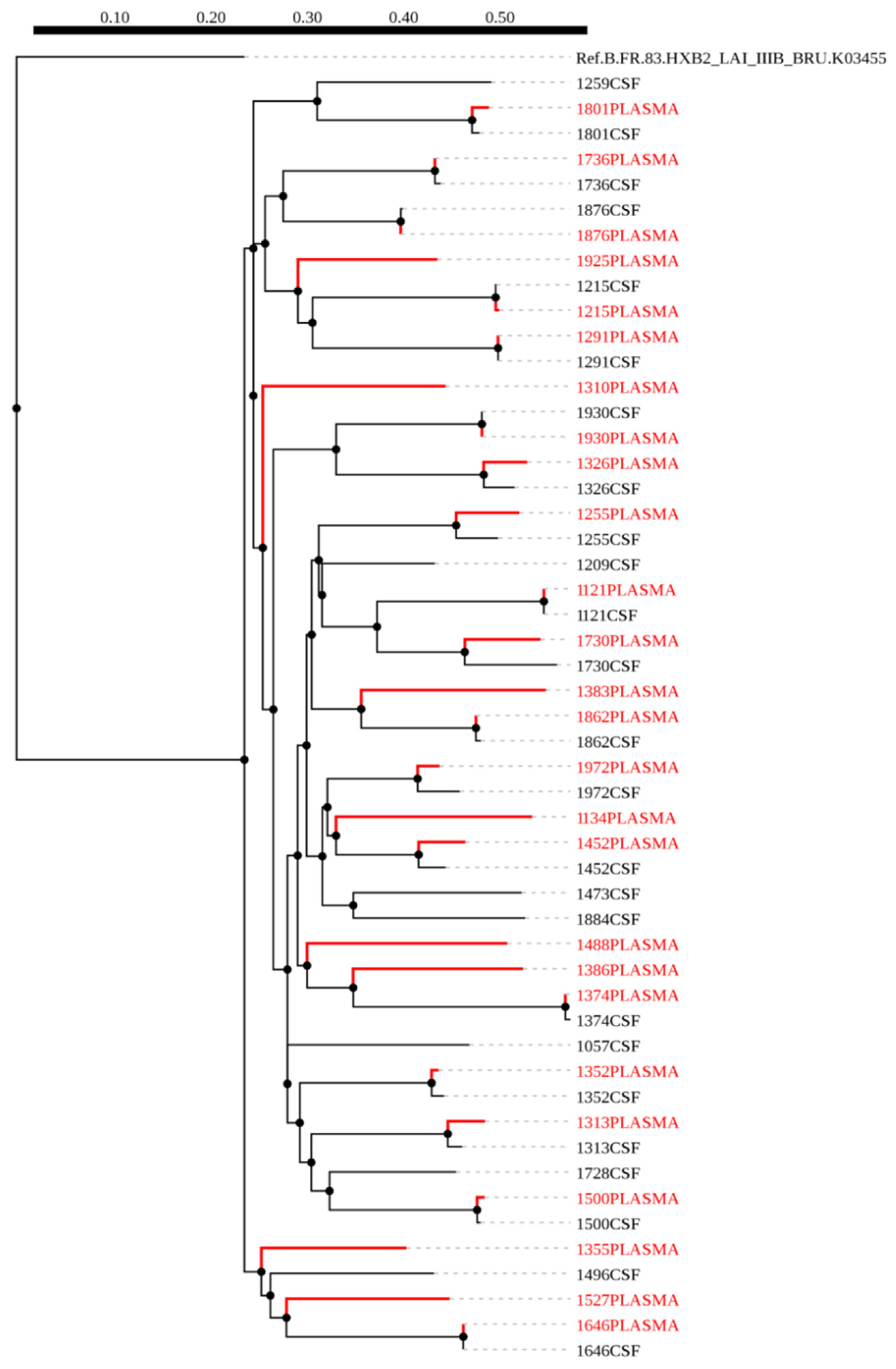
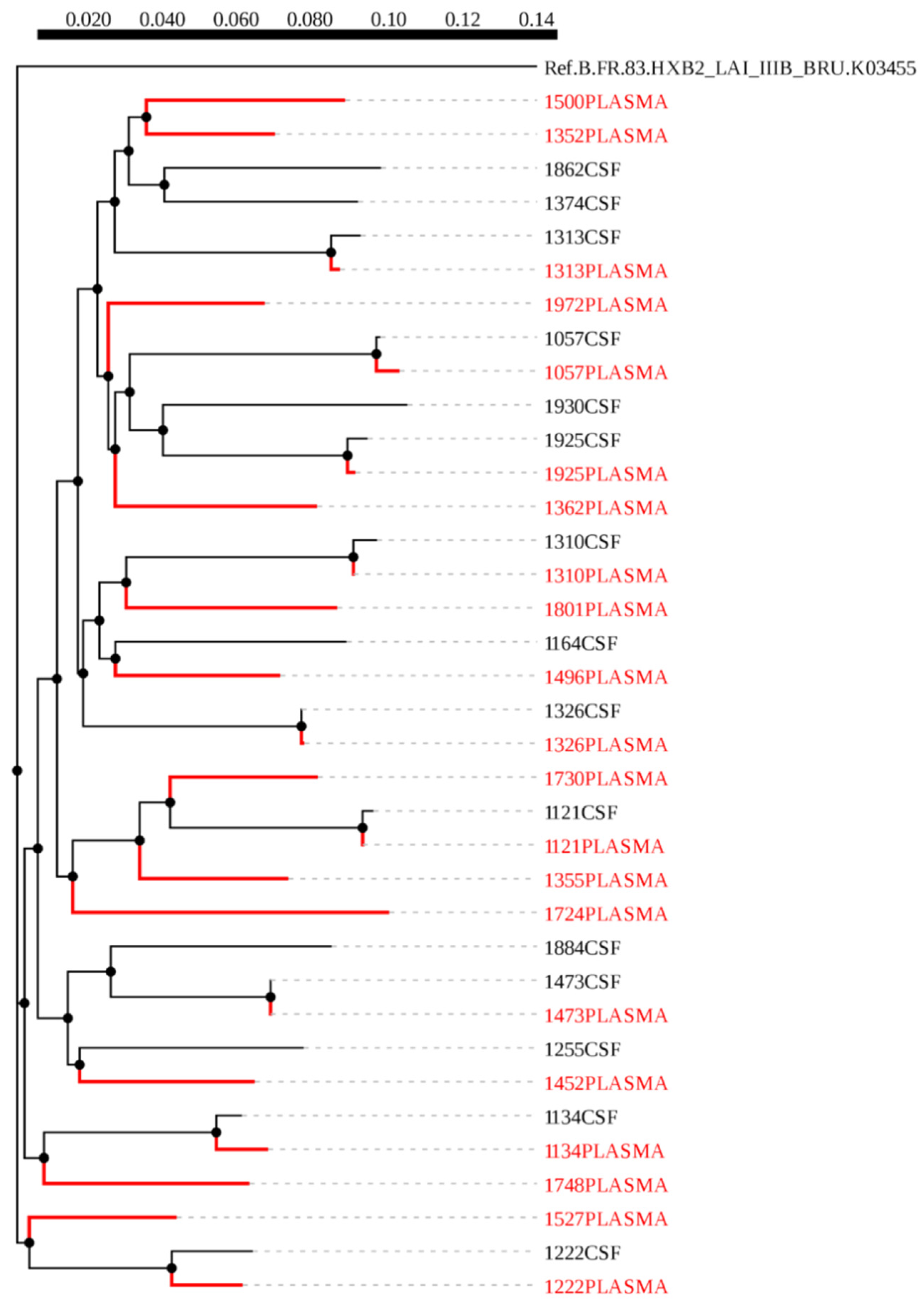
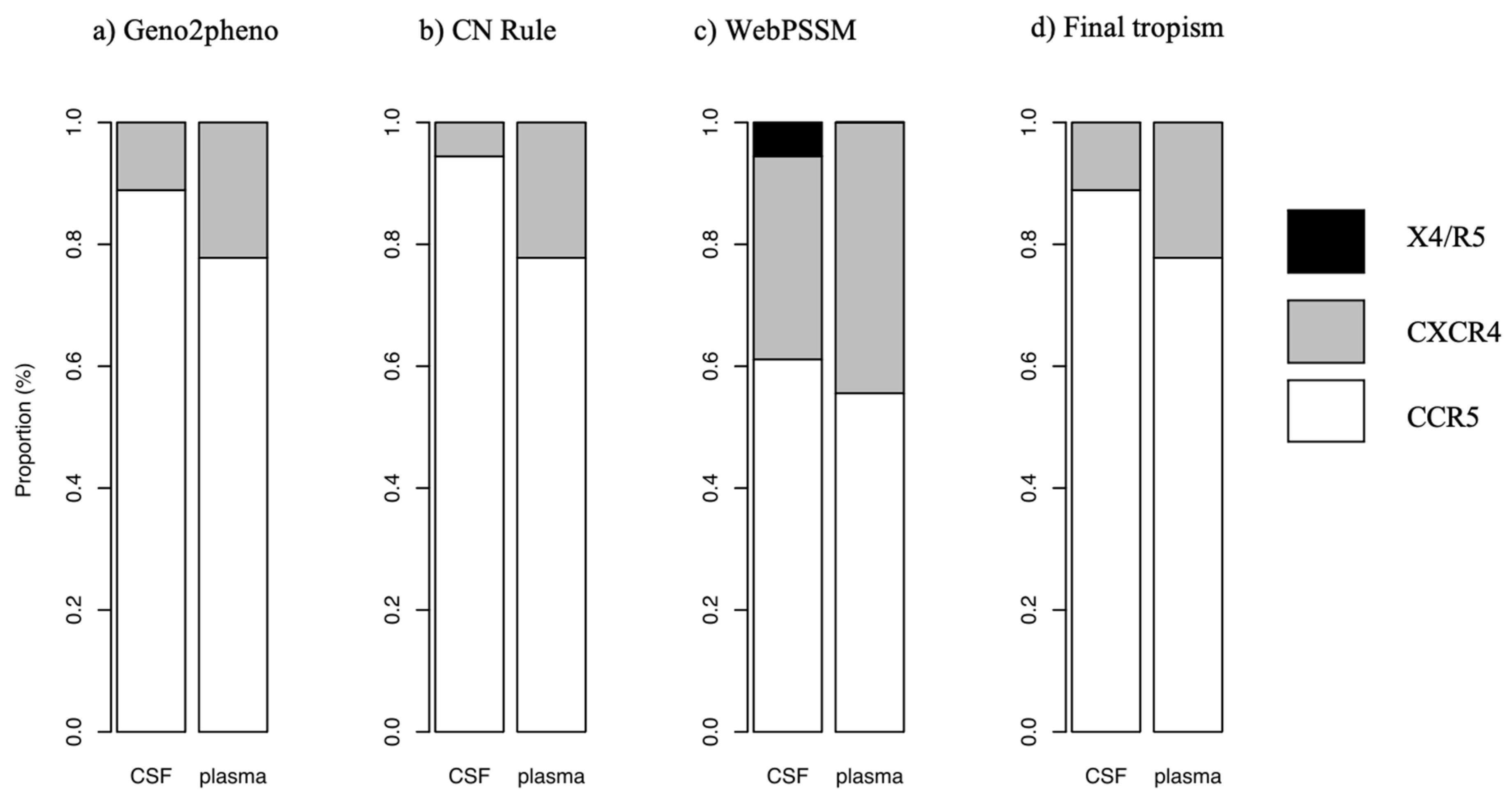
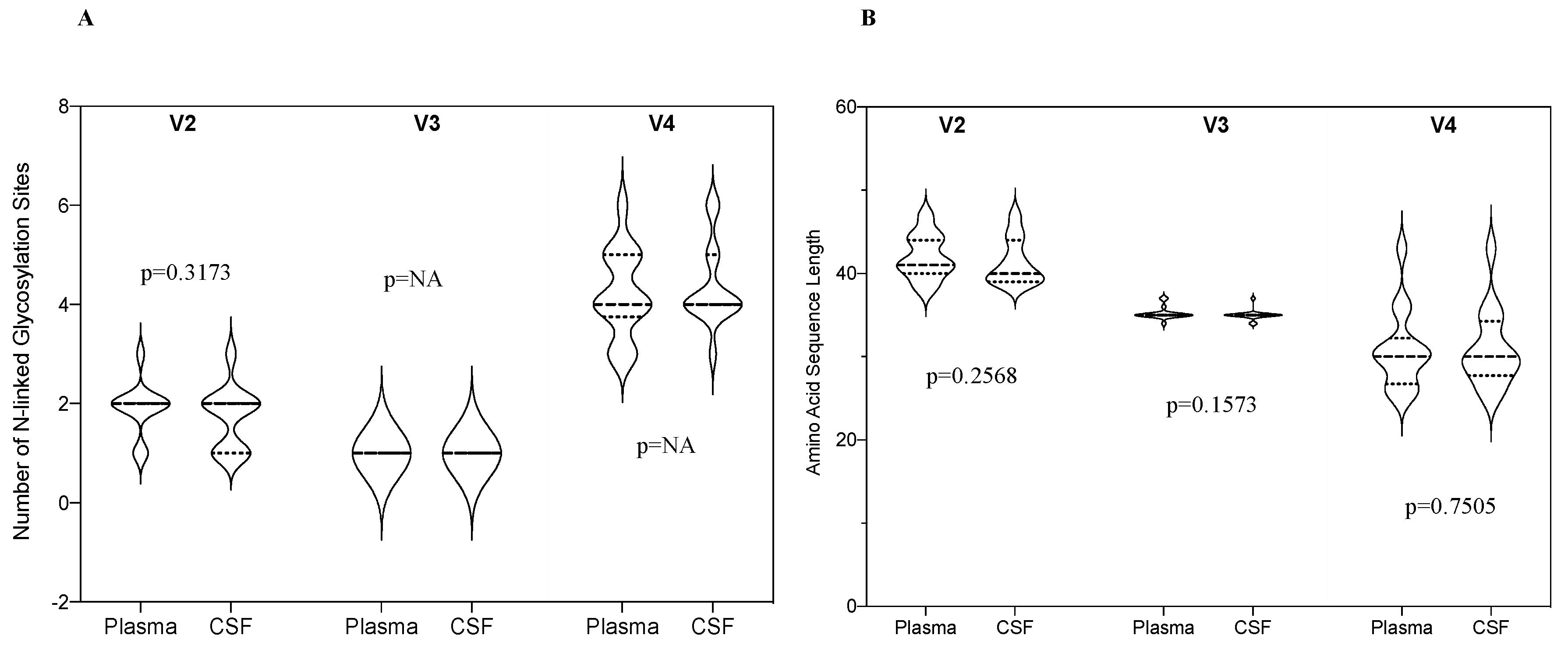
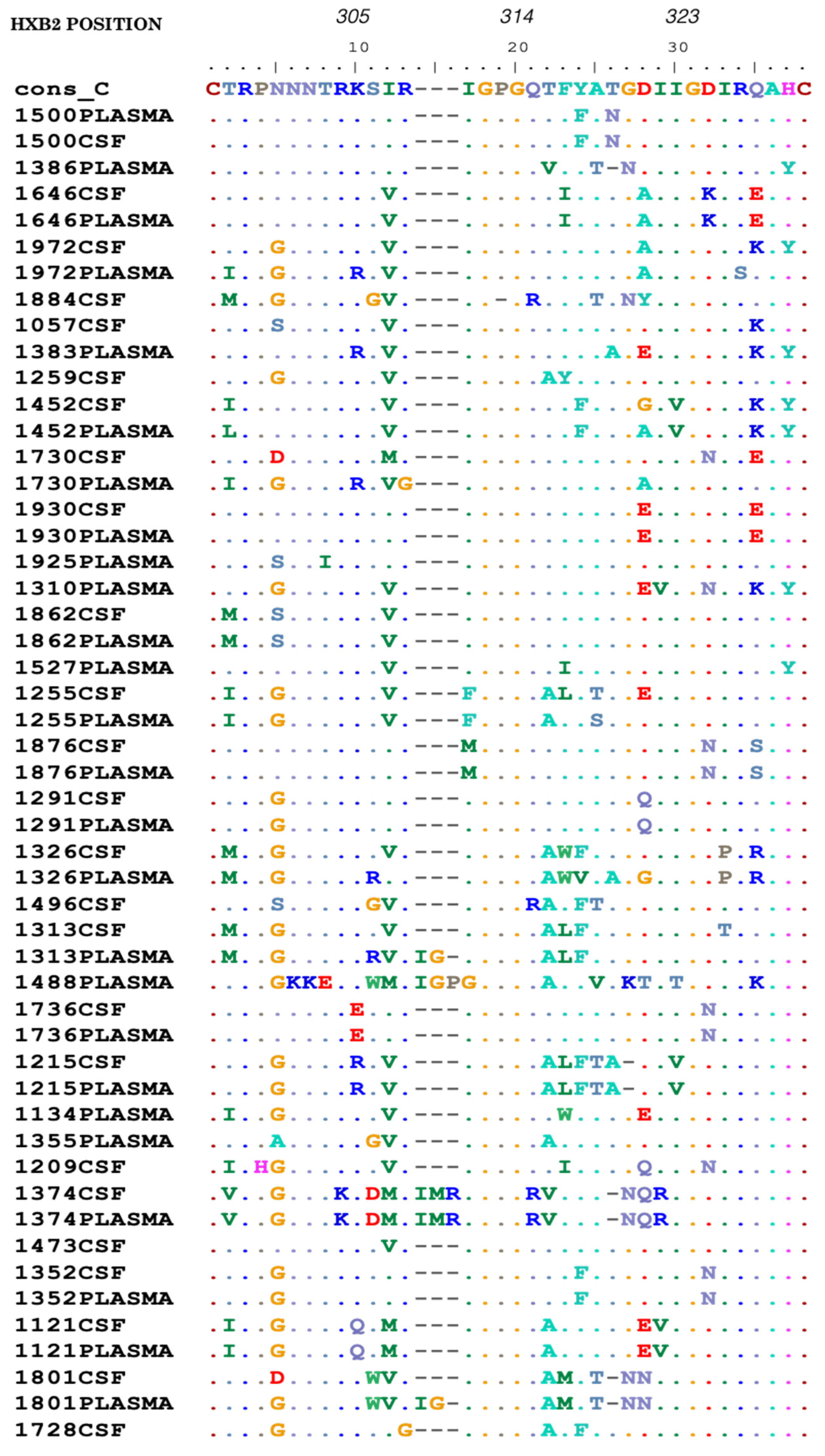
| Patient Characteristics, N = 41 | |
|---|---|
| Median age, years (IQR) | 38 (31–44) |
| Gender | |
| Male (%) | 59.5 |
| Female (%) | 40.5 |
| Median CD4 count, cells/μL (IQR) | 28 (10–44) |
| On ART or previously exposed, n (%) | |
| Yes | 21.4 |
| No | 78.5 |
| Median Viral load, log10 copies/mL | |
| Plasma | 5.1 (4.8–5.7) |
| CSF | 4.6 (3.7–4.9) |
| CSF WBC, cells/μL (IQR) | 10 (3.0–65.8) |
| Median Fungal burden, log10 CFU/mL (IQR) | 5.0 (4.1–5.7) |
| Sample ID | Sex | Age | CD4 Count | Fungal Burden | Viral Load | Epitope and Epitope Sequence | Compensatory Mutations | ||||||||
|---|---|---|---|---|---|---|---|---|---|---|---|---|---|---|---|
| TL9 | GL9 | RM9 | KK10 | NY10 | ISW9 | KF11 | TW10 | QW9 | |||||||
| 1057CSF | M | 27 | 24 | 5 | 4.9 | None | - | H28P | None | None | I147L | None | None | None | H219Q, I223V, M228I |
| 1057PLASMA | 5.8 | None | None | - | None | None | I147L | None | None | None | H219Q, I223V, M228I | ||||
| 1925CSF | F | 38 | 37 | 5 | 4.6 | Q182H | None | None | None | D260E | None | None | None | None | H219Q, I223V |
| 1925PLASMA | 4.9 | Q182H | None | None | None | D260E | None | None | None | None | H219Q, I223V | ||||
| 1310CSF | F | 23 | 22 | 6.2 | 4.6 | Q182A | - | - | - | - | I147L | None | None | - | None |
| 1310PLASMA | 5.8 | Q182A/T | None | H28R | L268M | None | I147L | None | None | None | None | ||||
| 1222CSF | F | 46 | 3 | 5.8 | 2.8 | None | G357S | H28R | None | None | None | None | None | A309S, T310S | I223V |
| 1222PLASMA | 3.9 | None | G357S | H28R, M30R | None | None | None | None | None | A309S, T310S | I223V | ||||
| 1326CSF | M | 34 | 10 | 6.1 | 4.0 | None | None | H28Q | None | None | None | None | None | None | H219Q, I223V |
| 1326PLASMA | 5.1 | None | None | H28Q | None | None | None | None | None | None | H219Q, I223V | ||||
| 1313CSF | F | 30 | 66 | 4.6 | 4.8 | None | G357S | None | None | D260E | I147L | None | None | None | I223V |
| 1313PLASMA | 5.7 | None | G357S | None | None | D260E | I147L | None | None | T310S | I223V | ||||
| 1134CSF | M | 37 | 222 | 3.6 | 2.8 | None | None | H28R | None | None | None | None | None | None | H219Q, I223V, M228L |
| 1134PLASMA | 4.1 | None | None | H28R | None | None | None | None | None | None | H219Q, I223V, M228L | ||||
| 1473CSF | M | 39 | 26 | 5.1 | 5.6 | None | G357S | None | None | None | I147L | None | None | None | S165N, I223V, M228I |
| 1473PLASMA | 5.1 | None | G357S | None | None | None | I147L | None | None | None | S165N, I223V, M228I | ||||
| 1121CSF | F | 30 | 8 | 4.7 | 5.3 | Q182S | G357S | H28Q | None | D260E | None | None | None | None | I223A |
| 1121PLASMA | 6.2 | Q182S | G357S | H28Q | None | D260E | None | None | None | None | I223A | ||||
| 1500PLASMA | F | 42 | 41 | 5.9 | 5.6 | None | G357S | H28R | None | None | I147L | None | None | T310S | I223V |
| 1972PLASMA | F | 36 | N/A | 4.1 | 5.7 | Q182S, T186S | None | H28Q | None | None | I147L | None | None | T310S | I223V, M228I |
| 1884CSF | M | 48 | 166 | 7.0 | 4.9 | Q182A | G357S | - | None | None | I147L | None | None | None | I223V |
| 1452PLASMA | F | 39 | 56 | 3.6 | NA | None | None | None | None | D260E | A146N, I147L | A163G | None | None | S165N, I223V |
| 1801PLASMA | M | 37 | 26 | 5.7 | 4.9 | None | None | - | None | D260E | I147H | None | None | None | M228I |
| 1164CSF | M | 39 | 53 | 4.9 | 2.6 | N/A | G357S | - | L268M | None | - | - | T242N | T310S | H219Q, I223A |
| 1730PLASMA | F | 35 | 28 | 5.9 | 5.3 | None | G357S | H28R | None | None | A146S | None | None | None | I223V, M228L |
| 1362PLASMA | F | 30 | 21 | 3.7 | N/A | None | None | H28Q | None | D260E | I147L | None | None | None | None |
| 1930CSF | M | 27 | 40 | 5.2 | 4.9 | None | None | H28Q | None | None | A146T, I147L | None | None | None | H219Q, I223V |
| 1862CSF | M | 36 | 37 | 4.7 | 5.4 | None | G357S | None | None | D260E | I147L | None | None | None | H219Q, I223V, M228I |
| 1527PLASMA | M | 44 | 30 | 5.3 | NA | None | None | H28Q, M30R | None | None | None | None | None | A309S, T310S | H219Q, I223V |
| 1255CSF | F | 41 | 5 | 5.6 | 4.6 | None | G357S | M30R | None | D260E | I147L | None | None | None | I223V |
| 1724PLASMA | M | 38 | 28 | 2.7 | 4.7 | None | G357S | None | None | None | None | None | None | None | I223V |
| 1496PLASMA | F | 25 | 8 | 6.7 | 4.8 | None | G357S | None | None | None | I147L | None | None | None | None |
| 1355PLASMA | M | 22 | 31 | 2.9 | 5.0 | Q182S | None | M30R | None | None | A146S | None | None | None | I223V |
| 1748PLASMA | M | 46 | 164 | 0 | NA | None | G357S | H28R | None | None | None | None | None | A309S | I223V |
| 1374CSF | F | 49 | 1 | 4.9 | 5.0 | None | G357S | - | None | None | None | None | T242N | None | H219Q |
| 1352PLASMA | M | 42 | 120 | 5.6 | 5.8 | None | None | H28Q | None | None | None | None | None | None | I223V |
Publisher’s Note: MDPI stays neutral with regard to jurisdictional claims in published maps and institutional affiliations. |
© 2020 by the authors. Licensee MDPI, Basel, Switzerland. This article is an open access article distributed under the terms and conditions of the Creative Commons Attribution (CC BY) license (http://creativecommons.org/licenses/by/4.0/).
Share and Cite
Kelentse, N.; Moyo, S.; Mogwele, M.L.; Ditshwanelo, D.; Mokaleng, B.; Moraka, N.O.; Lechiile, K.; Leeme, T.B.; Lawrence, D.S.; Musonda, R.; et al. HIV-1C env and gag Variation in the Cerebrospinal Fluid and Plasma of Patients with HIV-Associated Cryptococcal Meningitis in Botswana. Viruses 2020, 12, 1404. https://doi.org/10.3390/v12121404
Kelentse N, Moyo S, Mogwele ML, Ditshwanelo D, Mokaleng B, Moraka NO, Lechiile K, Leeme TB, Lawrence DS, Musonda R, et al. HIV-1C env and gag Variation in the Cerebrospinal Fluid and Plasma of Patients with HIV-Associated Cryptococcal Meningitis in Botswana. Viruses. 2020; 12(12):1404. https://doi.org/10.3390/v12121404
Chicago/Turabian StyleKelentse, Nametso, Sikhulile Moyo, Mompati L. Mogwele, Doreen Ditshwanelo, Baitshepi Mokaleng, Natasha O. Moraka, Kwana Lechiile, Tshepo B. Leeme, David S. Lawrence, Rosemary Musonda, and et al. 2020. "HIV-1C env and gag Variation in the Cerebrospinal Fluid and Plasma of Patients with HIV-Associated Cryptococcal Meningitis in Botswana" Viruses 12, no. 12: 1404. https://doi.org/10.3390/v12121404
APA StyleKelentse, N., Moyo, S., Mogwele, M. L., Ditshwanelo, D., Mokaleng, B., Moraka, N. O., Lechiile, K., Leeme, T. B., Lawrence, D. S., Musonda, R., Kasvosve, I., Harrison, T. S., Jarvis, J. N., & Gaseitsiwe, S. (2020). HIV-1C env and gag Variation in the Cerebrospinal Fluid and Plasma of Patients with HIV-Associated Cryptococcal Meningitis in Botswana. Viruses, 12(12), 1404. https://doi.org/10.3390/v12121404






